+++1964+++
In early 1964, following the release of his third record, The Times They Are a-Changin,’ singer-songwriter Bob Dylan toured through California for the first time. His first San Francisco Bay Area show was on Feb. 22, 1964 at the Berkeley Community Theater. Russ Wilson of the Oakland Tribune reported 3,100 persons in attendance, and describes an audience that was “preponderantly young, [with] a sizable sprinkling of listeners from the grade and junior high school bracket. . . . unusual, but not conclusive.”[1] Of Dylan’s appearance, Wilson writes: “a slender 22-year-old dressed in a green shirt open at the neck, a suede jacket, narrow dark trousers, unpressed and wrinkled at the bottom where they covered the tops of his brown boots. The marble whiteness of his face contrasted with his shock of unruly, curl-inclined dark hair.”[2] As for the music, Dylan was up at the mike with an acoustic guitar and his harmonica, solo. He played twenty songs,[3] opening with “The Times They Are A Changin’.” He also played “Who Killed Davey Moore” and “Talkin’ Bear Mountain Picnic Massacre Blues,” which “brought the house down.”[4] Apparently, throughout the show Dylan had trouble keeping his guitar in tune, and “during one particular long spell with the balky instrument, a baby in the audience started crying. Dylan passed it off lightly by quipping, ‘Listen to that baby cry while I get in tune.'” [5] Toward the end of the show, Dylan invited Joan Baez–who was the most popular and successful folk singer at the time–up on stage to join him for three songs, two of which were “With God On Our Side” and “Blowin’ in the Wind.”[6] Ultimately, Wilson champions Dylan’s songs as “real art” with lyrics of a “high order,” and declares him to be a young man well on his way to fulfilling Pete Seeger’s prediction that he would become “America’s greatest troubador.”[7] At this time, Dylan was fully embraced by the folkies, and here was being confirmed in his status as folk icon for those that saw folk music as presenting a more true and pure option to saccharine pop music.
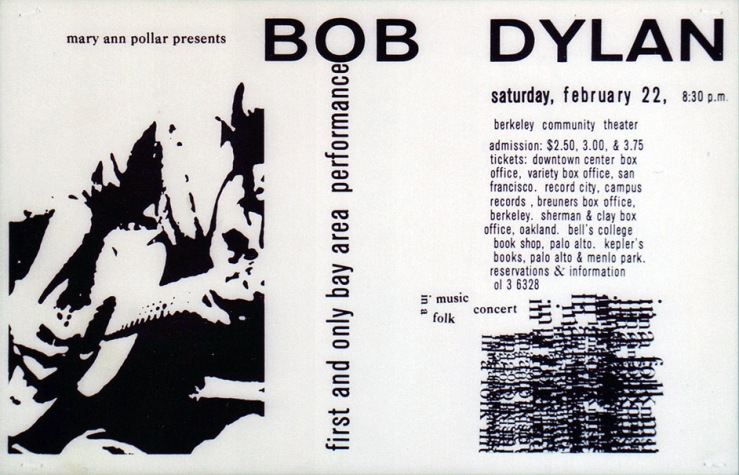
Following the release of Another Side of Bob Dylan later that year, Dylan returned to the Bay Area, first playing in San Jose at the Civic Auditorium on Nov. 25, 1964. A firsthand account of the San Jose show mentions a sparse crowd, and Dylan urging those in attendance to move up: ” “Can some of you come down front? I feel like I’m singin’ to an empty house,” Dylan reportedly said. “Blowin’ in the Wind,” “Mr. Tambourine Man,” “The Lonesome Death of Hattie Carroll,” and “It Ain’t Me Babe” with Joan Baez, are mentioned. Two days later, on Nov. 27, 1964, Dylan played his first ever San Francisco show at the Masonic. While the aforementioned Berkeley show had entertained the young, as well as the older folkies (Joan Baez’s appearance being icing on the cake), this Masonic appearance brings a more critical reaction (as of yet I’ve located no reviews of the San Jose show, though there is a recording (see link above), and these reflections). Of the SF show, Paul Hertelendy of the Oakland Tribune writes: “Dressed in a leather jacket and worn dungarees, [Dylan] strongly suggests a rock-‘n-roll singer who has discovered folk songs.”[8] Some were starting to doubt Dylan’s folk purity. “His songs tend to be wordy and long, and his words are often squeezed into a line with a compositorial shoehorn,” continued Hertelendy. “When he brings on a message or tries to wax eloquent, his vocabulary and poetry generally fall far short of the mark.”[9] Betraying folk club leanings, Hertelendy’s review ultimately turns into adoration for Joan Baez, who–similar to the February Berkeley performance–joins Dylan at the end of the show. To Hertelendy’s eyes and ears, she “sav[es] the show from incipient boredom.”[10]
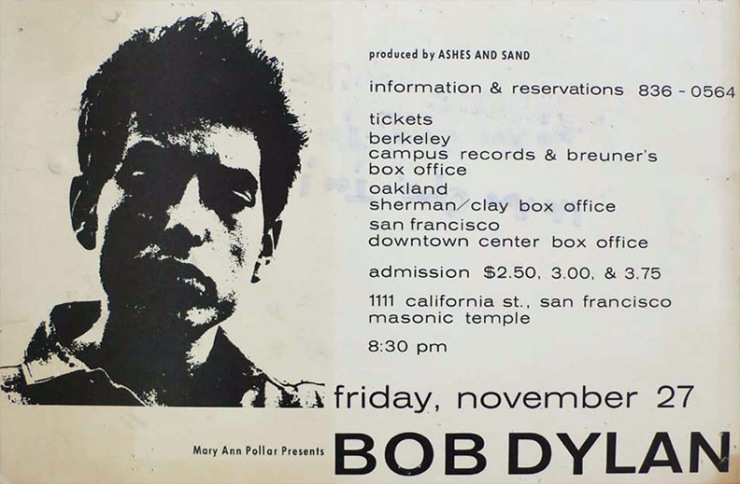
Thankfully, there exists a recording of this show. Which is helpful to contrast with Hertelendy’s review, as it reveals others enjoying themselves much more than Hertelendy was. It’s interesting to listen to with relation to the San Jose show. Six tracks, the recording remains the basis for the archived set list of this show, but of course many more songs were played. With Hertelendy’s input, “It Ain’t Me, Babe” can most likely be added to the end (with Joan Baez).[11] Also, you can tell before “Don’t Think Twice, It’s All Right,” the harmonica bit seems the end of “Tambourine Man,” and then after he says, “This is a true story that was taken out of the newspaper,” and strums his guitar, checking the tuning. He’s about to play “The Lonesome Death of Hattie Carroll.” This seems most likely to be the second set.[12]
In contrast to the Berkeley performance in February, what is seen here by the audience in San Jose and SF is a major shift in Dylan’s songwriting. At this time, Dylan was writing songs faster than he could record and release them, and much of his set was starting to consist of new, long, lyrically-complex songs like “Gates of Eden” and “It’s Alright, Ma (I’m Only Bleeding),” neither officially released until the following year. Hertelendy isn’t sure what to make of Dylan, and says of him: “a Western-hillbilly singer who has gone folk.”[13] The newer songs appear to have gone right over him, as he says that “If You Gotta Go, Go Now (Or Else You Got To Stay All Night),“–which operated as a bit of comic relief between the two aforementioned songs–was Dylan’s “best effort” of the night.[14] As Dylan broke away from the traditional folk mold, critics like Hertelendy saw him as a sell-out, despite the fact that his new songs were pushing the boundaries of both folk and popular music. Dylan is a “song ‘stylist’ rather than a folk singer,” wrote Hertelendy, “devilishly close to the stereotype popular singer.”[15]
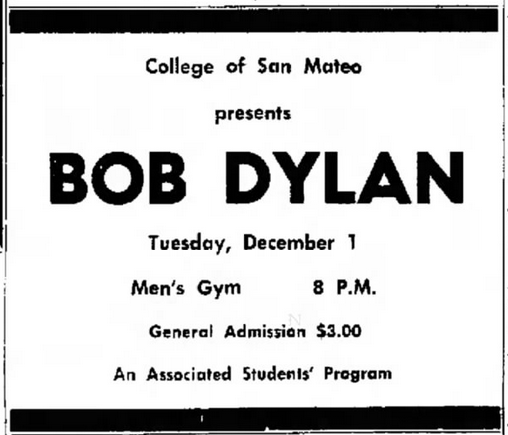
Another bit that helps elucidate Bay Area reactions to Dylan’s performances at this time–specifically the split between the old and the young–comes from San Mateo’s The Times, in which Garry Niver reviews a show that took place on Dec. 1, 1964 in the “Men’s Gym” of the College of San Mateo. While Niver carries a view of Dylan that many older folks had (like Hertelendy above)–his guitar or harmonica playing isn’t that great, his singing is often off key, etc.–his approach is with more empathy for the audience, who he witnessed as being “awed by the vocal imagery and philosophy which this young genius disseminated among them.”[16] Conflicted, the title the paper chose for the review: “Bob Dylan Bad, But Good.”[17] Niver declares Dylan the “newest high priest of the beat-pacifist set,”[18] and while he seems to not really like Dylan, he does praise some of the songs. Interestingly, he mentions, “It’s alright Ma, it’s Just the World,” how Dylan must have been introducing “It’s Alright, Ma (I’m Only Bleeding)” at the time. Of this song, Niver writes, “a rambling talking blues bit, he strips the hypocrites and reveals the paradoxes of complex life.”[19] Dylan did two sets, and opened the first with the “theme song of his movement,”[20] “The Times They Are a-Changin’.” (It’s easy to imagine a first set at the 1964 Masonic show discussed above opening with this song as well.) Other details mentioned by Niver: Dylan “moved into the uptempo ‘[Don’t Think Twice,] It’s Alright’ and ‘It Ain’t Me Babe,'” and “concluded the evening with the poignant ‘Ballad of Hattie Carroll.'”[21] This all lines up with the Masonic show, as well, minus of course the encore with Joan Baez. Niver ends his review with lyrics from “Hard Rain’s A-Gonna Fall,” so likely was played, as well.
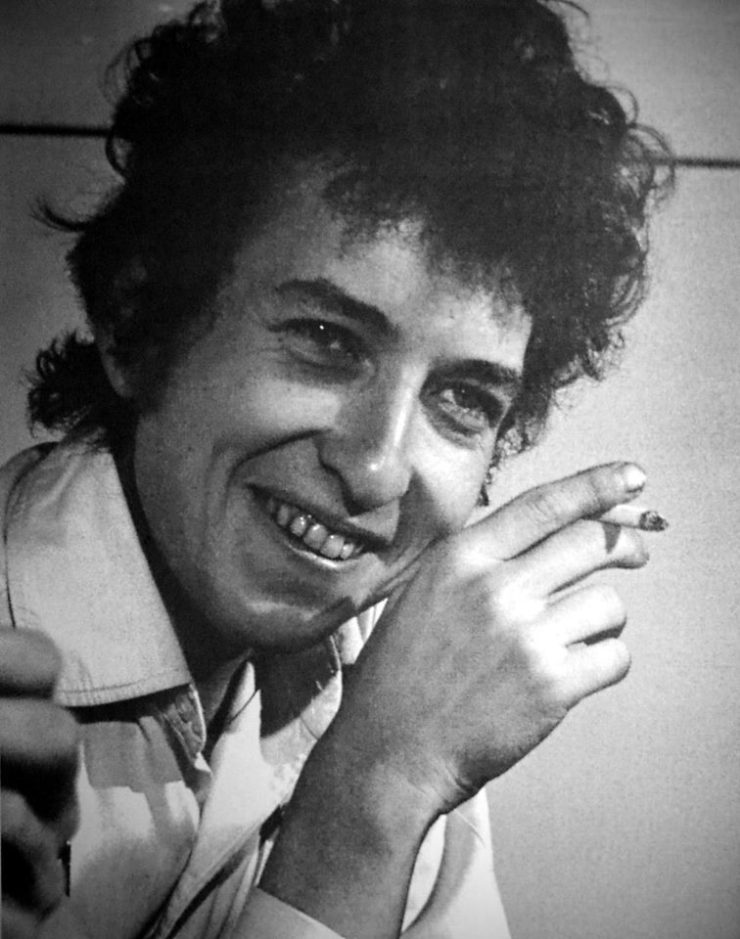
*******
+++1965+++
Early in 1965, back in NYC, Dylan recorded his fifth album, Bringing It All Back Home. Released on March 22 of that year, for the first time since his very first single, “Mixed-Up Confusion” (1962) and “Corrina, Corrina” from his 2nd album The Freewheelin’ Bob Dylan (1963), there were songs featuring a backing band. While all of the songs on the solo second side had been performed at live shows in 1964 (“Mr. Tambourine Man,” “Gates of Eden,” “It’s Alright Ma (I’m Only Bleeding),” and “It’s All Over Now, Baby Blue”), the songs with band–which made up the entire first side–were all new, and to those who cared if Dylan broke out of the traditional folk mold, the first song on the record, “Subterranean Homesick Blues,” was a punch to the gut.
Surrounding the release of Bringing It All Back Home, Dylan returned to California for a number of shows, mostly in Southern California. His only Bay Area appearance [21a] at this time took place on April 3rd at the Berkeley Community Theater. Russ Wilson of the Oakland Tribune, once again, was there: “Not only was every one of the auditorium’s 3,200 seats plus an additional 100 chairs in the orchestra pit occupied, there were dozens of persons outside the hall offering to pay a premium to anyone who would sell his ticket to the concert,”[21b] Wilson reported.
“On stage, [Dylan’s] appearance and presentation . . . show changes. The dark, wrinkled pants have been replaced by tailored blue trousers and the green shirt, open at the neck, by a neat light blue number that was buttoned. The leather boots and jacket and the tousled hair still remain. . . . Dylan went through his repertoire with celerity and sureness. There were few of the shy smiles and spoken comments that were a notable part of his first concert here. To some listeners, this lessened the rapport. . . . . Several humorous songs provided fine balance.” [21c] Wilson notes the following songs as being played: Mr. Tambourine Man, Gates of Eden, The Times They Are a’Changin, The Lonesome Death of Hattie Carroll, Talking World War III Blues, and With God on Our Side.
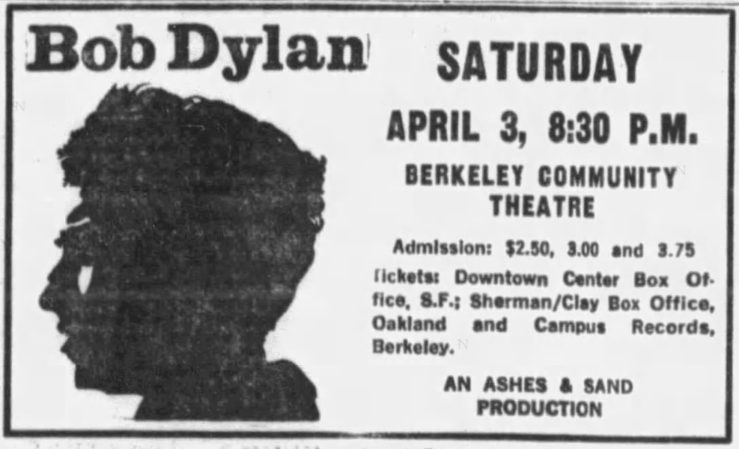
Later in April, Dylan traveled to England for a tour, where he was expected to basically regurgitate his 1964 shows. You can see this in Don’t Look Back, as Dylan grapples with his rising fame. Newer tracks from Back Home, like “She Belongs to Me” and “Love Minus Zero/No Limit” were being played. (One may imagine these songs were played at the April 1965 Berkeley show, but who knows.)
Once back in NYC, in the summer of 1965, Dylan started writing and recording his sixth record, Highway 61 Revisited. Except for the final track, “Desolation Row,” the entire record was electric, with a band. On July 25, 1965, just a handful of days after releasing the record’s first single, “Like a Rolling Stone,” Dylan performed at the Newport Folk Festival, where in 1964 he had officially reached the status of folk “deity, sanctified and beatified by the adulation heaped upon him by the adoring audience.”[22] This year, however, Dylan chose to play his set with a backing band, more in the style of his current recordings. A now-famous performance, Dylan and his band were booed, and many of the folk-elite were not sure how to take it. While the myth of this performance got buffed down into being about the traditional folkies versus new electric Dylan, in his book, Like the Night, CP Lee discusses some other interesting theories that booing could have also been due to sound issues, the briefness of their set, etc. Whatever the case, “[Dylan] left the stage and never returned to Newport. From now on Dylan would play it his way, or not at all.”[23] All of this is well-documented; there is film footage of the 1965 Newport performance. You can see some of it in Part 2 of Martin Scorsese’s 2005 documentary, No Direction Home.
Whatever the reason for the booing at Newport, it was indicative of what was to come for Dylan and his band as they geared up for their tour schedule surrounding the release of Highway 61 Revisited. The first show of the tour happened on Aug. 28, 1965 at Forest Hills Tennis Stadium in Queens, N. Y., two days before the release of the record. This show is legendary among Dylan enthusiasts for the booing (recording here). At one point, in a strange communal effort, the crowd starts chanting, “We want Dylan!” as if they were at a sporting event, perhaps psychologically influenced by the venue.
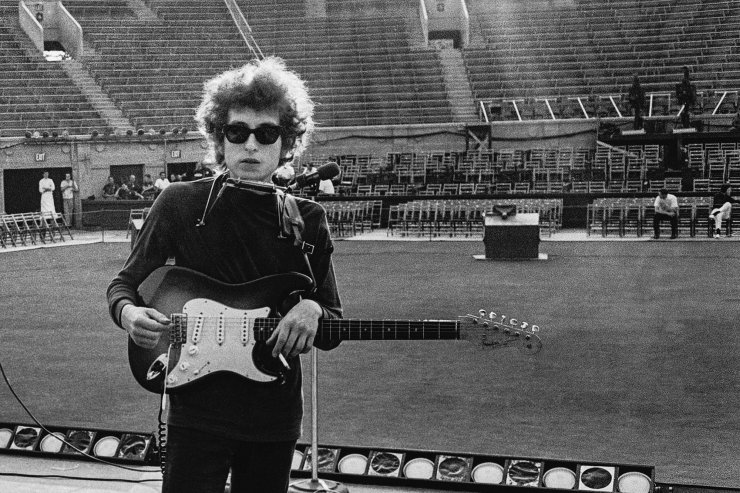
In late-1965, at the tail end of this tour, Dylan returned to the Bay Area for four shows. The first two shows took place in Berkeley on Friday, Dec. 3 and Saturday, Dec. 4 at the Berkeley Community Theater, then shows in SF and San Jose, Saturday, Dec. 11 at the Masonic and Sunday, Dec. 12 at the Civic Auditorium. Apparently, when the SF show presumably sold out, a second Masonic show was added for Sunday, Dec. 5; however, I can locate no record of this Dec. 5 show actually taking place. In fact, a review in the Chronicle on Dec. 6, focuses on the two Berkeley shows, and while mentioning the upcoming Dec. 11 show at the Masonic, mentions nothing of a show happening there the day before. So in the end, it seems possible that not enough tickets were sold for the Dec. 5 show to take place.[24]
On Friday, Dec. 3, before the first of the two Berkeley shows, a press conference (embedded below) with Dylan took place at 525 4th St. in SF, a building that operates today as a band rehearsal space. Dylan enjoys spiraling things into a Dadaesque realm, versus having folks take him too seriously, as a “protest” singer, or someone with a message, etc. According to him, it’s “mathematical music,” and if that has made him popular, then so be it.
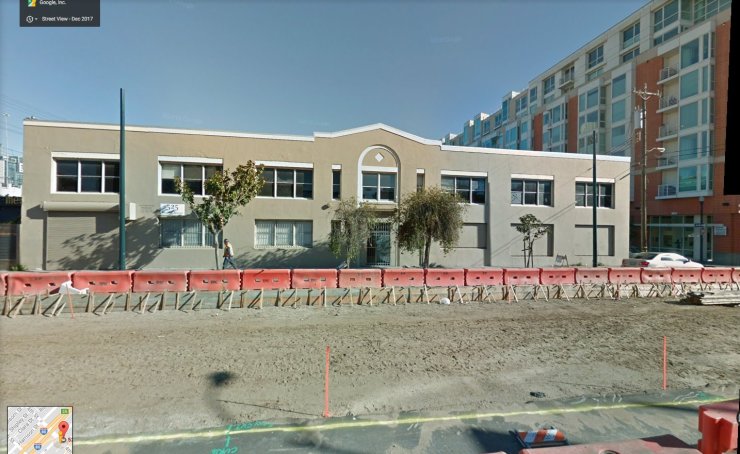
This press conference is helpful in placing a number of folks important to Dylan’s Bay Area connections. Mary Ann Pollar (see second image in article), the person behind Dylan’s first two Bay Area appearances in 1964, is up front and center. After the conference, you can hear her mention the party she was having that night after Dylan’s show. Also, poet Lawrence Ferlinghetti, founder of City Lights Books in North Beach, and poet Allen Ginsberg are present, as are poet Michael McClure, and some others that would spend time with Dylan during his visit.
Dylan was friends with Ginsberg, who planned to visit SF for these shows. Dylan gave Ginsberg a ton of tickets to distribute. Therefore, this happening–that is Dylan’s presence in the Bay Area–brought about a City Lights reunion of sorts, which was reported in the Chronicle on Dec. 6, in an article titled, “Portrait of the Artists as Old Men.” Photographers came to City Lights Books at 261 Columbus Ave. and took group photographs of those assembled for the occasion. In retrospect, the photos taken that day are the most known and viewed of this group of poets and artists, their existence facilitated by folks coming together for Dylan’s 1965 Bay Area shows.
“I was looking at those great old photographs of the Paris surrealists in the ’20’s,” the Chronicle reports Lawrence Ferlinghetti saying that day. “I thought it’d be a good thing to get one like that (of the local poets) before the whole scene disappears in a cloud . . . the end of an era . . . It just is.”[25] The article reports “half a dozen photographers and about 50 culturally dispossessed bystanders on the scene as the poets–about 30, counting hangers-on–gathered together. Folksinger Bob Dylan–resplendent in dark jacket, sunglasses and polka-dot shirt–caused a brief flurry as he passed through the sidewalk throng on his way to Vesuvio’s bar next door.”[26] Dylan was staying way down the street at the Villa Roma Motor Hotel where North Beach meets Fisherman’s Wharf (today known as the SF Marriott Fisherman’s Wharf).[27]
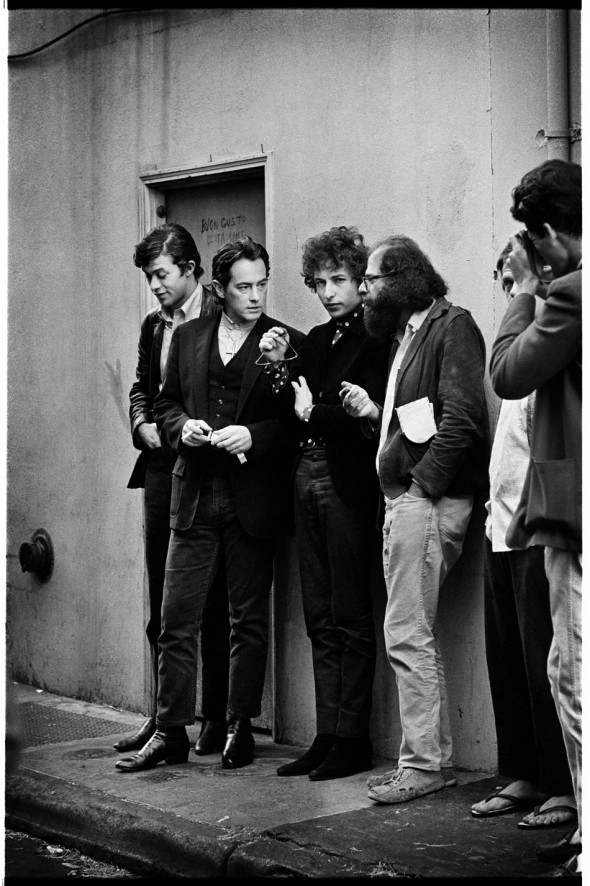
Herb Caen, who had the ability of being everywhere in SF at once, spotted Dylan before the press conference: “Early Fri. morning [Feb. 3],” Caen reports, “into La Tosca on Columbus trooped Folksinger Bobby Dylan, Poets Allen Ginsberg and Laurence Ferlinghetti, Italian Designer Ettore Sott-Sass and a few others–whereupon the waitress took one look at the assorted beards and sandals and announced: ‘We must maintain some sort of standards around here–out, out, everybody out!’ Out they went, muttering and sputtering.”[28]
Dylan was 24-years old in 1965, or “well under thirty,” as joked at the press conference. Ferlinghetti (who turns 100 years old today!) was 46. Ginsberg was 39. City Lights was around twelve years old at this time, and given their influence on Dylan’s writing, Dylan was introducing their work to a new generation. It was a good reason to get everyone together. In Scorsese’s No Direction Home, Allen Ginsberg recalls the first time he heard “A Hard Rain’s a-Gonna Fall.” He says he started weeping as he realized the torch had at last been passed from the 50s to the 60s.
There are no existent tapes of the Berkeley Community Theater shows on Dec. 3 and Dec. 4. [29] However, the main reviews I located were of these two shows, one a glowing review by Ralph Gleason, who is the man that brings Dylan out at the press conference. Gleason attended both Berkeley shows, and has a lot to say: “They didn’t boo Bob Dylan in Berkeley when he brought out his electric guitar and his rock ‘n’ roll band. Instead they cheered and shouted ‘bravo! bravo!’ . . . On both the Friday and Saturday night shows, a curious rapport existed with the audience. . . . Both nights, Dylan, resplendent in a brown shetland suit with perpendicular, black, inch-wide houndstooth jagged checks, his hair, like the brownish wires standing out from his head . . .”[30] As was customary on this tour, Dylan played the first set by himself, with acoustic guitar, and harmonica. He appears to have played the same set each night, except on Dec. 4 he played a new song in the first set, called “Freeze Out.” He mentions having just finished it at the press conference. Later renamed “Visions of Johanna,” it was eventually included on Blonde on Blonde in 1966. Considered by many to be one of Dylan’s greatest songs, this was the first time Dylan played it live.[31] Other songs in the first set included “Gates of Eden,” “To Ramona,” Love Minus Zero,” and “Mr. Tambourine Man.” Both nights the acoustic set closed with “It’s All Over Now, Baby Blue” and “Desolation Row,” which “on both nights . . . brought down the house.”[32]
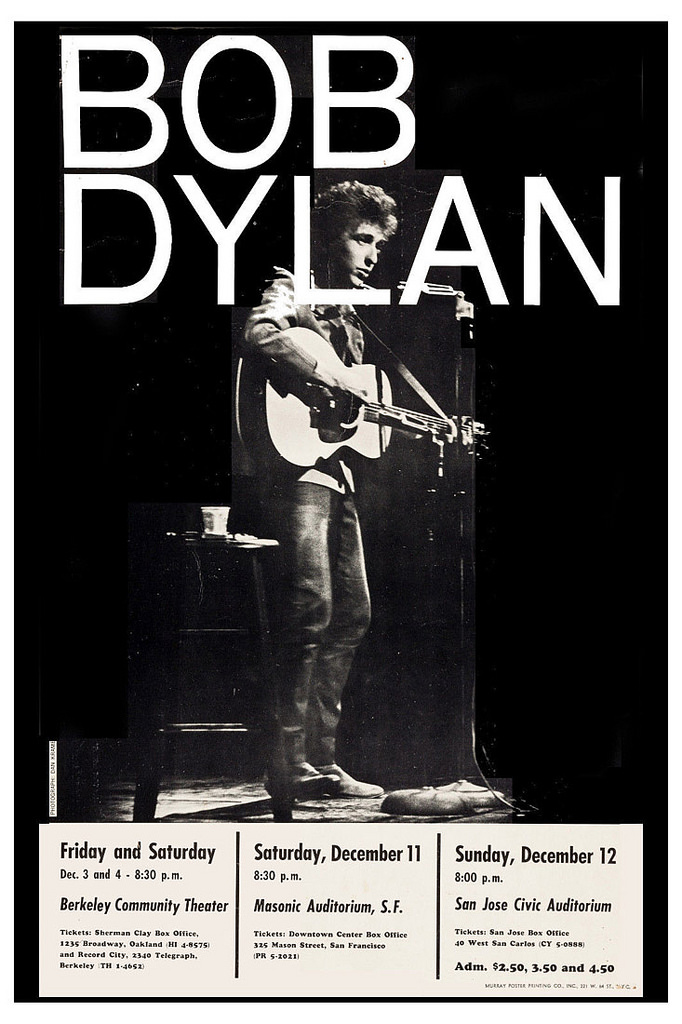
As for the second set with band, according to Gleason, “both nights . . . the second half wiped everybody out. Dylan’s rock ‘n’ roll band, which caused such booing and horror-show reaction at the Newport Folk Festival and elsewhere, went over in Berkeley like the discovery of gold.”[33] Gleason says, “the band is great. Just great . . . It is a loud band, but an exciting and delightful band full of kicks and flashes of great moments. It is obvious Dylan blows his mind playing with them. He even broke a guitar string Saturday night and did a couple of numbers without the guitar, just wailing on the harmonica.”[34] He reports them playing “I Don’t Believe You,” “Baby, Let Me Follow You Down,” “It Ain’t Me, Babe,” “Tombstone Blues,” “Just Like Tom Thumb Blues,” “Ballad of a Thin Man,” “Positively 4th Street,” (which brought “screams of joy both nights”) and “Like a Rolling Stone.” There was also another one played on both nights that Gleason couldn’t get a name for due to “the hurricane of sound.” [Probably “Long Distance Operator” played in SF and San Jose.][35] “Dylan is obviously in transition,” continues Gleason, “his program now represents the midpoint and it is clear that at any minute he will abandon the solo singing except for occasional numbers, and do the whole show with the band. The next step will be a portable lighting system to enhance the surrealistic effect the paintings [above the band were four Bob Neuwirth paintings: ‘In each painting, from the space man to the rock ‘n’ roll players, the figures were an abstraction of Dylan’s own image’] and Dylan’s costume already give the stage.”[36]
“It is a powerful experience in more than musical terms to dig [Dylan’s] concerts,” writes Gleason. “The audience’s relationship to the singer is possibly the most direct and powerful I have ever witnessed. He moves them in a deep and sometimes disturbing way and the occasional bad sound doesn’t interfere; enough comes through emotionally.”[37] Gleason reports that Ginsberg, Ferlinghetti, Ken Kesey, and two Hell’s Angels were sitting in the front row on Dec. 3. Lastly, he writes, “Dozens of university professors were scattered in the audience, some looking rather shattered by the experience. On both nights, the audience lingered in the hall and on the steps outside . . . They simply didn’t want to go home.”[38]
Russ Wilson of the Oakland Tribune (who reviewed Dylan’s first Bay Area show in February 1964) also weighed in on the Feb. 3rd show. “Almost everyone in the audience that nearly filled the 3,400-seat auditorium seemed satisfied with the result,”[39] he reported. Way more detached and reserved than Gleason, Wilson continued: “there were no boos . . . As a matter of fact there was quite a bit of applause in Berkeley, but whether this was for Dylan alone or extended to his five associates . . . no one could tell.”[40] Of Dylan’s look: “The singer wore a brown suit with a pattern as distinct as a checkerboard. The jacket buttoned all the way up to his throat. This, his thick shock of hair, and his pasty-white face created the impression that he could be either male or female.” [41] Later, Wilson also comments on what he sees as an androgynous section of the crowd: “This same ambivalence extended to that segment of the audience in which boy-girl hairdos were common.”[42] A bit standoffish on his final take of Dylan, Wilson relates the band to those of T-Bone Walker’s or Muddy Waters’s, but then bashes Dylan’s voice: “All it needed was a topflight singer (which Dylan isn’t)”.[43] Lastly, according to Wilson, the peak of the set was “Ballad of a Thin Man,” when Dylan played piano, and all of the lyrics could be heard.
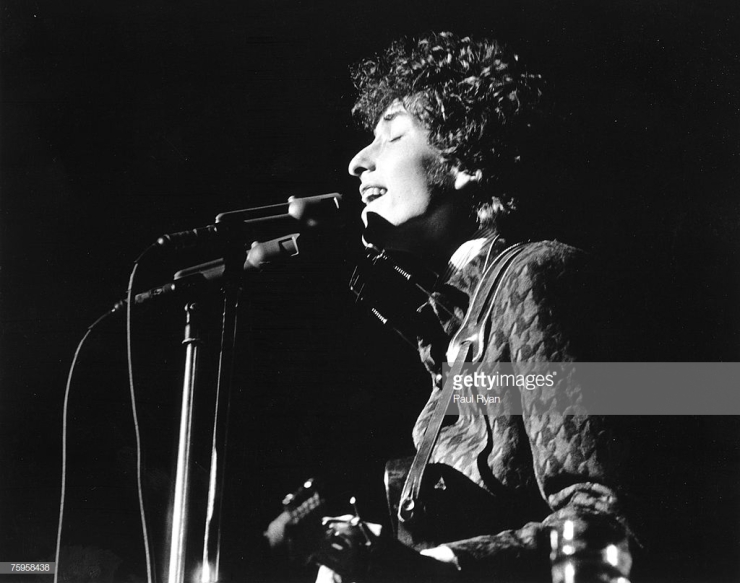
The following weekend, on December 11, Dylan played at the SF Masonic once again, this time with the band. Basically, they played the same set as the Berkeley shows (though Dylan’s band now featured a different drummer[44]). Thanks to Allen Ginsberg, and a tape machine he purchased for $500, there is an existent recording of this show (appears the tracks are now split up on YouTube for whomever’s financial benefit), as well as the San Jose show that happened on the following night (these recordings were found just a few years ago). Along with the shows themselves, Ginsberg also records conversations with Dylan backstage, and interviews random concertgoers.
The recordings begin with December 11, as Ginsberg sets up the tape machine backstage at the Masonic and shows it to Dylan. Dylan then tells Ginsberg about hanging out with Marlon Brando; they talk about David Meltzer (who Dylan had met before–Ginsberg tells Dylan that Meltzer is now playing electric guitar [45]); a bit where Dylan asks someone to divert a woman named Bonnie [McLean?]; also he tells Ginsberg he spoke with Phil Spector about perhaps recording Ginsberg. At one point, someone comes in and gifts Dylan some frankincense, an eagle feather, and a piece of turquoise.
“I felt kind of close to the concerts last time I was here,” Dylan says. “It was groovy, you know? That seldom happens.” At another point, Dylan talks about the shows the previous weekend: “When I played [in Berkeley] last weekend it was the first time in a very long time–since England actually when I first began playing–that I felt actually embarrassed at being dug . . . It got a hold of me somewhere. It’s not like that all the time. Obviously, it can’t be.”
During intermission between the solo and band sets at San Jose, Dylan reflects on the Masonic show the previous night: “Last night you saw [a show] that was . . . I dug it . . . San Francisco . . . I sort of felt who they were out there.” At another point, he explains, “[Generally] I’m not even thinking about [the audience], whereas I actually did think about the San Francisco audience.” Trying to explain to Ginsberg the difference between feeling an audience or not, Dylan says, “It’s like when you walk by a deserted house and you know somebody’s in there, or if you walk by a deserted house and you know somebody’s not in there. It’s a different house. You go steal food if there’s nobody there, and if there’s somebody there you try to make friends and get something to eat.”
Attempting parables aside, the San Jose recording is perhaps the clearer of the two shows recorded by Ginsberg, however, according to Dylan during intermission, it’s just a “typical concert.” “This could be anywhere, man,” he says to Ginberg. The crowd at San Jose is appreciative. According to a female fan after the show, Dylan “had the whole audience right in his hand . . . he was just wonderful.” Ginsberg asked her about the second [electric] set: “I like both,” she says.
San Francisco resonated with Dylan at this time, and within the greater context of popular culture, the importance of these shows to the SF community and music scene should not be denied. By the time 1967 rolled around, however, as SF psychedelic music started spilling from speakers all over the world, Dylan was nowhere to be found, for following a motorcycle crash in the summer of 1966, he sought seclusion.
When Dylan released John Wesley Harding in late-1967, people realized the psychedelic/rock’n’roll Dylan of the mid-60s was history. “I don’t know how I got to write those songs,” said Dylan in 2004. “All those early songs were like almost magically written . . . I did it at one time . . . I can’t do that [now].”[46]
[1] Oakland Tribune, Feb. 24, 1964, p. 9, c. 4-7.
[2] Ibid.
[3] The Pony Express (Sacramento City College), Feb. 27, 1964, p. 6.
[4] Ibid.
[5] Ibid.
[6] Ibid. Given that the reviewer of this show says it started with “The Times They Are a Changin’,” it’s worth noting that the set list that’s out there for this show among Dylan enthusiasts, does not get this correct. Furthermore, “Bear Mountain” is missing from this list, as well. The third song with Baez is missing as well. While we can’t be sure what the song is, both Wilson of the Oakland Tribune and Bill Broughton of The Pony Express say they played three songs together.
[7] Oakland Tribune, Feb. 24, 1964, p. 9, c. 4-7.
[8] Oakland Tribune, Nov. 28, 1964, p. 15, c. 2-4.
[9] Ibid.
[10] Ibid.
[11] Given the lengthy applause, it seems clear that this is when Baez first came onto the stage, and they played “Mama, You Been On My Mind.” It seems doubtful they would have done just one number, so as Hertelendy reports, they probably played “It Ain’t Me, Babe” next.
[12] It seems that maybe the recorder was anticipating new material to record, as noticeably, the recording begins in the third verse of “Gates of Eden.” Likewise, there are other editing on-and-offs throughout. From my perspective, it appears most likely that the recording is primarily most of a second set.
[13] Oakland Tribune, Nov. 28, 1964, p. 15, c. 2-4.
[14] Ibid.
[15] Ibid.
[16] The Times (San Mateo), Dec. 3, 1964, p. 36, c. 1-2.
[17] Ibid.
[18] Ibid.
[19] Ibid.
[20] Ibid.
[21] Ibid.
[21a] While a March 28, 1965 Berkeley (or UC folk festival) show is mentioned a few places online, I can’t find any solid traces of it. Dylan played in Santa Monica on March 27. If this other Berkeley appearance happened, it doesn’t appear to have been open to the public. Both the Oakland Tribune, and the S. F. Examiner speak of the April 3 show as Dylan’s “single Bay Area engagement” on this tour. (Oakland Tribune, Mar. 4, 1965, p. 37, c. 2; S. F. Examiner, Mar. 28, 1965, p. 228) Lastly, on the day this show supposedly took place, the Oakland Tribune makes no mention of it while mentioning the upcoming April 3 show. See Oakland Tribune, Mar. 28, 1965, p. 89.
[21b] Oakland Tribune, April 5, 1965, p. 17, c. 2-3.
[21c] Ibid.
[22] CP Lee, Like the Night (London: Helter Skelter Publishing, 2004), 54.
[23] Ibid., 63.
[24] Oakland Tribune, Nov. 28, 1965, p. 105; SF Chronicle, Dec. 6, 1965, p. 53.
[25] SF Chronicle, Dec. 6, 1965, p. 7.
[26] Ibid.
[27] Rolling Stone, March 14, 1974.
[28] SF Chronicle, Dec. 6, 1965, p. 31.
[29] It was once thought there was a tape of one of these Berkeley performances, but ends up it was the Dec. 12 San Jose show.
[30] SF Chronicle, Dec. 6, 1965, p. 53.
[31] Therefore, Ginsberg’s recording of the song at the Masonic, Dec. 11, 1965, is its earliest recording.
[32] SF Chronicle, Dec. 6, 1965, p. 53.
[33] Ibid.
[34] Ibid.
[35] Ibid.
[36] Ibid.
[37] Ibid.
[38] Ibid.
[39] Oakland Tribune, Dec. 4, 1965, p. 11.
[40] Ibid.
[41] Ibid.
[42] Ibid.
[43] Ibid.
[44] Dylan informs Ginsberg of this during the backstage recording before the show.
[45] David Meltzer and his wife, Tina’s band, The Serpent Power, released a record in 1967.
[46] 60 Minutes interview from Dec. 5, 2004.
APPENDIX
The Set Lists
Feb. 22, 1964 — Berkeley Community Theater
The Times They Are a-Changin’
One Too Many Mornings
Restless Farewell
North Country Blues
Only A Pawn In Their Game
Who Killed Davey Moore?
Talkin’ Bear Mountain Picnic Massacre Blues [not sure exactly where but it was played]
Walls Of Red Wing
Eternal Circle
Chimes Of Freedom
[Unknown song w/ Joan Baez]
With God On Our Side (w/ Joan Baez)
Blowin’ in the Wind (w/ Joan Baez)
Nov. 25, 1964 — Civic Auditorium, San Jose
The Time They Are a-Changin’
[Blowin’ in the Wind?]
Talkin’ John Birch Paranoid Blues
To Ramona
Gates of Eden
If You Gotta Go, Go Now
It’s Alright, Ma (I’m Only Bleeding)
Mr. Tambourine Man
Hard Rain’s a-Gonna Fall
Talkin’ World War III Blues
Don’t Think Twice, It’s All Right
[The Lonesome Death of Hattie Carroll]
[It Ain’t Me, Babe (w/ Joan Baez)]
Nov. 27, 1964 — The Masonic, San Francisco
[First half of show is unknown, but probably started with “The Times They Are a-Changin'”]
Gates of Eden
If You Gotta Go, Go Now
It’s Alright, Ma (I’m Only Bleeding)
Talkin’ World War III Blues
Mr. Tambourine Man [?]
Don’t Think Twice, It’s All Right
The Lonesome Death of Hattie Carroll
Mama, You Been On My Mind (w/ Joan Baez)
It Ain’t Me, Babe (w/ Joan Baez)
Dec. 1, 1964 — Men’s Gym, College of San Mateo
The Times They Are a-Changin’
It’s Alright, Ma (I’m Only Bleeding)
Don’t Think Twice, It’s All Right
It Ain’t Me, Babe
A Hard Rain’s a-Gonna Fall
The Lonesome Death of Hattie Carroll
April 3, 1965 — Berkeley Community Theater
Mr. Tambourine Man
Gates of Eden
The Times They Are a-Changin’
The Lonesome Death of Hattie Carroll
Talking World War III Blues
With God on Our Side
[It’s All Over Now, Baby Blue]
Dec. 3, 1965 — Berkeley Community Theater
[solo]
Gates of Eden
To Ramona
Love Minus Zero / No Limit
Mr. Tambourine Man
Visions of Johanna
It’s All Over Now, Baby Blue
Desolation Row
[w/ band]
I Don’t Believe You
Baby, Let Me Follow You Down
It Ain’t Me, Babe
Tombstone Blues
Unknown Song [Long Distance Operator, most likely]
Just Like Tom Thumb’s Blues
Ballad of a Thin Man
Positively 4th Street
Like a Rolling Stone
Dec. 4, 1965 — Berkeley Community Theater
[solo]
Gates of Eden
To Ramona
Love Minus Zero / No Limit
Mr. Tambourine Man
Visions of Johanna
It’s All Over Now, Baby Blue
Desolation Row
[w/ band]
I Don’t Believe You
Baby, Let Me Follow You Down
It Ain’t Me, Babe
Tombstone Blues
Unknown Song [Long Distance Operator, most likely]
Just Like Tom Thumb’s Blues
Ballad of a Thin Man
Positively 4th Street
Like a Rolling Stone
Dec. 11, 1965 — The Masonic, San Francisco
[solo]
To Ramona
Gates of Eden
It’s All Over Now, Baby Blue
Desolation Row
Love Minus Zero / No Limit
Visions of Johanna
Mr. Tambourine Man
[w/ band]
Tombstone Blues
I Don’t Believe You
Baby, Let Me Follow You Down
Just Like Tom Thumb’s Blues
Long Distance Operator
It Ain’t Me, Babe
Ballad of a Thin Man
Positively 4th Street
Like a Rolling Stone
Dec. 12, 1965 — Civic Auditorium, San Jose
[solo]
She Belongs to Me
To Ramona
Gates of Eden
It’s All Over Now, Baby Blue
Desolation Row
Love Minus Zero / No Limit
Mr. Tambourine Man
[w/ band]
Tombstone Blues
I Don’t Believe You
Baby, Let Me Follow You Down
Just Like Tom Thumb’s Blues
Long Distance Operator
It Ain’t Me, Babe
Ballad of a Thin Man
Positively 4th Street
Like a Rolling Stone
[?] Oakland Tribune, Nov. 22, 1964, p. 55.
[??] Oakland Tribune, Nov. 28, 1965, p. 105; SF Chronicle, Dec. 6, 1965, p. 53.

Records also show that Dylan played a show at the San Jose Civic on Nov. 25, 1964. You don’t mention it. https://www.setlist.fm/setlist/bob-dylan/1964/san-jose-civic-auditorium-san-jose-ca-63d7ba23.html
Hi Mark, thank you for catching this. I indeed missed this one… I will amend when able, appears there’s audio of it out there as well. Appreciate it.
In the spring of 1965 Dylan also played in the Bay area:
1965 March 28 and April 03 concerts at [again] the Community Theatre in Berkeley
see http://www.bobdylan.com/setlists?filter_year=1965 [no setlists there though]
For the April 03 concert I found a review by [again] Russ Wilson in the Oakland Tribune of 1965 April 05, he mentions:
“There were few of the shy smiles and spoken comments that were a notable part of his first concert here…
He sang several new ones, including the spirited “Mr.Tambourine Man” and the imagery-rich “Gates of Eden.” There also were such Dylan standards as “The Times They Are a’Changin’,” “The Lonesome Death of Hattie Carroll,” “Talking World War III Blues,” and “With God on Our Side.” Several humorous songs provided fine balance.
Dylan’s voice seems to have improved a bit though it still is highly personal. ”
see https://www.newspapers.com/newspage/354623649/?terms=Dylan
Hey, much thanks for this, I will investigate further, and update when I can. UPDATE: While I was able to dig up a bit about the April 3, 1965 Berkeley show, there’s nothing about a March 28 show. In fact, both the Oakland Tribune and S. F. Examiner report of the April 3 show as the only Bay Area engagement of the tour. FYI. Thx